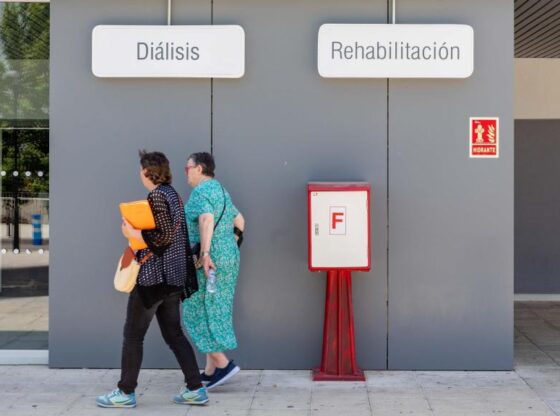You will forgive me, but I refuse to stop insisting. To shut up and join the wave of indolence and apathy that seems to envelop us and makes us not even protest. As a society, we cannot have six million people – 12% of the population – in some phase of the health waiting list and not say anything.
There are millions of lives cut short, millions of people living between fear and uncertaintywho do not know if they will arrive on time and who have no other option but to wait. Because they do not have the means to sneak into the public sector – as all politicians and workers in the National Health System do – nor do they have the possibility of resorting to private services.
And for all this—I already feel sorry for some—neither “health privatization” nor private healthcare is to blame.
The blame must be sought in an Administration whose bureaucratic machinery is infernal. In a system of autonomous powers that is overwhelmed. And in the excessive interest in continuing to protect a health management model—that of direct public management—that seeks to perpetuate itself for the rights of its workers, above the interest of citizens and the care of their health, which is what it was created for.
How else would it take us a year to diagnose an insidious process? Or to know, at least, if it is benign or malignant?
The latest official data on waiting times in Spanish public healthcare confirm what we have been seeing in recent years: We have never had so many people waiting for an operation, a consultation or a diagnostic test.
More than 850,000 patients are awaiting surgery and almost five million are awaiting a first consultation with a specialist. They are not abstract figures: they are real lives that are on pause, in a decline that seems eternal.
The data leaves no room for doubt. According to the Ministry of Health, as of June 2025 the average wait for surgical interventions in the entire National Health System (SNS) is around 118.6 days.
The wait for a first consultation with the specialist – the big plug that prevents us from knowing what is happening to patients – is 96 days.
And in Primary Care, according to the latest Health Barometer 202540.6% of the population that made an appointment with their family doctor waited at least eight days to be seen. This is, furthermore, one of the main reasons for the oversaturation of hospital emergencies: many citizens do not know where to turn.
At the national level we still do not have data aggregated and compared by autonomous communities on waiting times for diagnostic tests or the delivery of their results. In some cases, such as failures of screeningsit has been known that they can take up to three months.
A real nonsense. And this should be the first problem that needs to be urgently addressed in our public health system.
To begin with, there is no homogeneous, real and updated system that allows us to know the waiting times in the different stages that a patient goes through.
However, settling for that would be unambitious, because many patients need several diagnostic tests and several consultations with different specialists. Which, by pure logic, multiplies waiting times exponentially.
We should talk about the average time necessary for a definitive diagnosis by specialties or pathologies. But, being as we are, and although it is difficult to believe in the era of big data, it seems like a utopia to even consider it.
Everyone can understand, for example, that counting surgical waiting times from when the specialist makes the indication is not the same as counting from when the anesthetist confirms suitability after the preoperative study. Well that. In 2025, although it may seem incredible, we will continue the same.
“A shock plan with visible impact in 6-12 months would include the guaranteed referral of the patient to another accredited provider (public or private) when a maximum period for any diagnostic or therapeutic procedure or technique is exceeded”
These figures obviously reveal a problem of accessibility, but also of equity: not all citizens expect the same nor do all territories offer the same deadlines.
And the most striking thing is that The increase in the public health budget – over 50% in the last ten years – has not managed to correct this delay. On the contrary, waiting times have worsened.
Among the underlying causes are organizational rigidity (inflexible staff, inherited structures); the lack of effective coordination mechanisms between levels of care and between public and subsidized centers; the underutilization of the capacity already installed; and the absence of real incentives for managers and professionals to reduce waiting lists.
Added to this are bureaucracy, the lack of a fully interoperable digital system that guarantees continuity of care and chronic overload in certain services.
All this leads us to a conclusion: The problem is not about money, but about the model.. The system must rethink its operation. And it is true that deep decisions would have to be made to make it more productive and efficient.
But we are no longer here to speculate, because the health of citizens is at stake.

Thus, although these days the president has used public-private collaboration as an instrument of political attrition, the most effective solution would be a shock plan with automatic referral to whoever can assist. Because the president and his advisors, beyond the political game, are perfectly aware that The National Health System does not have sufficient resources of its own.
They will say that mud is for home. I don’t mind.
First, because the private sector does not need it — we are already doing well now. And, second, because I am much more concerned about those millions of citizens who have no choice but to wait for a measure that, if the Administration reacted, would not have to have a great impact on the accounts of the private sector.
If I had to choose a single measure to launch a shock plan with visible impact in 6-12 months, it would be this: the guaranteed referral of the patient to another accredited provider (public or private) when a maximum deadline for any diagnostic or therapeutic procedure or technique is exceeded.
I would set it directly at 30 days for everything, although they would tell me that it is impossible. In any case, demanding deadlines must be established and adapted to the specialty and complexity.
“Every day that a patient waits is a day of pain, functional impairment or lost opportunity. If we accept that health is a right, then the delay becomes a violation of that right”
A digital monitoring system must be created in real time, shared by all the autonomous communities and centers (public and subsidized), which makes it possible to know how many patients exceed the deadlines, where the bottlenecks are and what additional capacity can be mobilized.
In addition, it must be established that, if the maximum period is exceeded in the initially assigned center, the patient has the automatic right to be treated in another accredited center (public or subsidized) with the capacity to do so.
A payment mechanism per resolved episode should also be applied, with objective, valid and unified rates for the entire national territory, which compensate rapid resolution with quality control and clinical results. In this way, centers would have a real incentive to reduce waits.
Finally, when technically possible, shared medical history and continuity of care must be guaranteed, so that the patient does not lose information or feel “referred” as a mere procedure. He must perceive that the system coordinates him, not that he transfers him from hand to hand.
And that’s it.
If the “defenders” of public health want to continue defending their arguments, what they must do is energize public institutions so that they provide the best possible service to patients.
Because this plan:
– Places the patient at the center: the right is not to wait, but to receive care within a reasonable time.
– It forces the system to mobilize existing capacity, rather than waiting for “more budgets” or “more operating rooms.”
– It generates a clear and measurable incentive for managers: if they do not comply, they lose patients.
– It allows for quick results (visible reduction in time) and generates confidence in citizens.
– And, by being based on data and a monitoring platform, it provides transparency and makes visible what until now remains hidden.
Launching this plan does not require a complex revolution, but political willa sufficiently good data infrastructure – which already exists, at least in part – and a strong commitment from all levels of the system. It is the decisive “move” so that waiting stops being the elephant in the room of Spanish public health.
In healthcare, the most scarce resource is not money, not even professionals – although they are critical – but time. Every day a patient waits is a day of pain, anxiety, functional impairment or lost opportunity. If we accept that health is a right, then the delay becomes a violation of that right.
Therefore, the time has come to stop looking at waiting lists as a technical or exclusive problem for hospitals. We must see them for what they truly are: a reflection of equity, efficiency and respect for the patient.
And one last note to reflect on: Social justice is not defined by who takes care of you, but rather by the State taking care of you when you need it.regardless of the means to do it.
***Juan Abarca is president of HM Hospitales.

